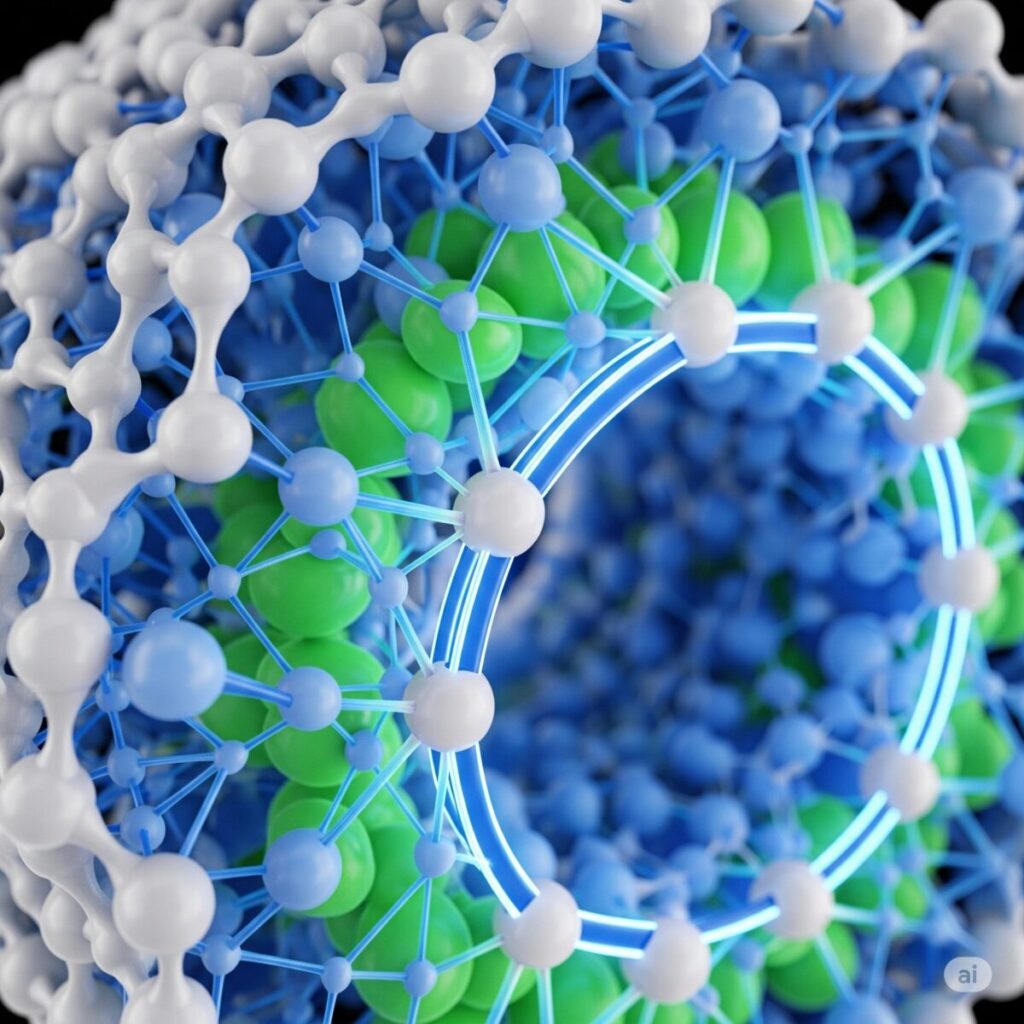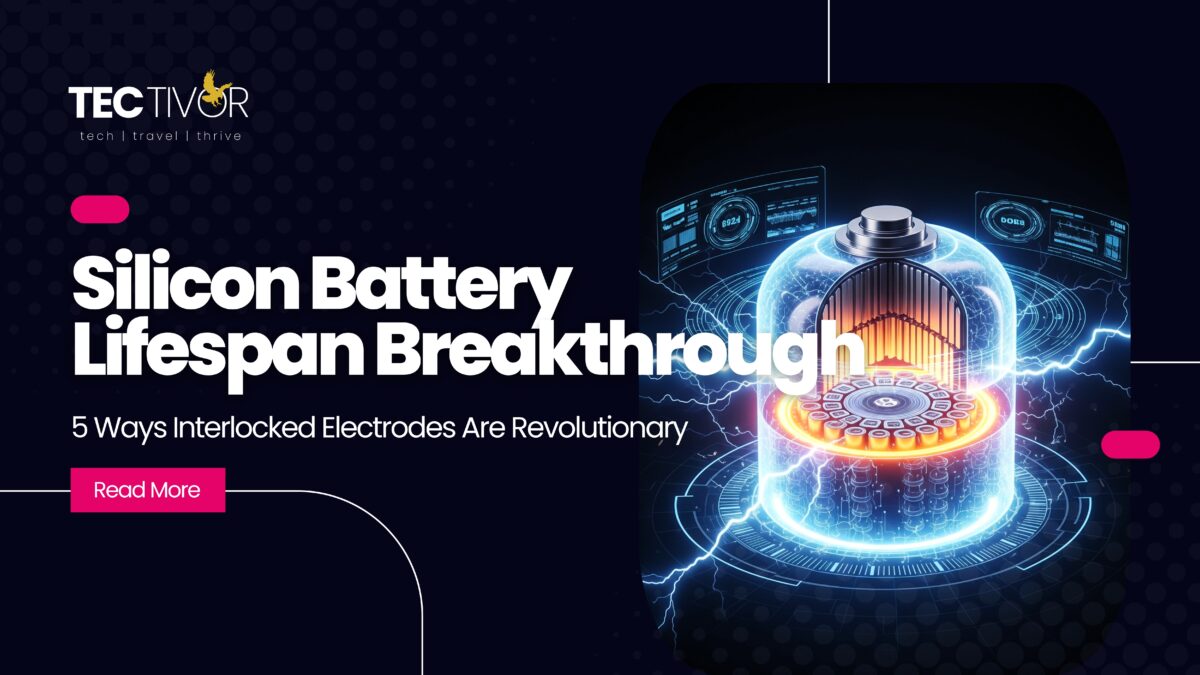Silicon Battery Lifespan – The race to develop longer-lasting, higher-capacity batteries has been at the heart of materials science for decades. While lithium-ion batteries have powered a digital and electric revolution—from smartphones to electric vehicles—their performance is nearing a plateau. At the core of this limitation lies the graphite-based anode, a component that, while reliable, has reached the upper limits of its energy storage capabilities.
Silicon anodes, long hailed as the next step in battery evolution, hold the promise of dramatically higher energy density—up to ten times greater than graphite. Yet, this potential comes with a caveat: a problematic swelling and shrinking behavior that leads to battery degradation. Now, a revolutionary innovation called interlocked electrodes offers a viable solution, unlocking silicon’s full potential and pointing the way to an electrified future with longer battery life and higher performance.
In this article, we’ll explore the mechanics of interlocked electrode technology, its implications for energy storage, and why it may soon transform not only electric vehicles but also consumer electronics, renewable energy, and aerospace.
Table of Contents
Silicon Battery Lifespan – The Promise and Peril of Silicon Anodes
Silicon is abundant, inexpensive, and theoretically offers a specific capacity of about 3600 mAh/g, compared to 372 mAh/g for graphite. This means that batteries using silicon anodes could be significantly smaller and lighter while storing far more energy. Imagine an electric vehicle with twice the range, or a smartphone that needs charging only once every few days.
But the excitement around silicon comes with significant technical hurdles. The same property that gives silicon its high energy capacity—its ability to absorb lithium ions—also causes it to expand by up to 400% during charging. As the battery discharges, silicon contracts. This constant swelling and shrinking leads to:

- Mechanical Fractures: The material breaks apart, leading to capacity loss.
- SEI Layer Instability: A protective coating forms and breaks repeatedly, consuming lithium.
- Loss of Electrical Contact: Detachment from the current collector and electrolyte.
- Low Coulombic Efficiency: Much of the lithium becomes irreversibly bound during the first few charge cycles.
These problems have so far confined silicon anodes to small-scale or hybrid applications. But that may soon change.
Interlocked Electrodes: A Paradigm Shift in Battery Design
Enter interlocked electrodes, an innovative approach that re-engineers the battery from the ground up. Rather than allowing the anode and electrolyte to merely coexist in contact, this technique chemically bonds them together—creating a seamless, durable interface that can handle the stresses of repeated charge and discharge cycles.
What Are Interlocked Electrodes?
The term refers to a structure where the silicon electrode and the electrolyte are chemically intertwined. This is achieved through an In Situ Interlocking Electrode–Electrolyte (IEE) system. During assembly or initial cycling, functionalized binders in the silicon react with crosslinkers in the quasi-solid-state electrolyte, forming covalent bonds that lock the two together.
Think of a brick wall. In traditional batteries, the “bricks” (electrodes) sit loosely on top of the “mortar” (electrolyte). In an IEE system, those bricks are chemically fused to the mortar, preventing them from shifting, cracking, or falling apart—even under stress.
Key Components of the IEE System:
- Functionalized Binders: Typically acrylate-functional polymers that interact chemically with the electrolyte.
- Quasi-Solid-State Electrolyte (QSSE): Provides improved safety and stability over liquid electrolytes.
- Crosslinkers: These molecules react with the functionalized binders to create a bonded network.

Why It Matters: The Game-Changing Advantages
The interlocked electrode design addresses all major silicon anode challenges:
Mechanical Stability
The bonded network prevents electrode particles from detaching or cracking, allowing the silicon to expand and contract without structural damage.
Stable SEI Layer
The strong interface prevents repeated rupture and formation of the SEI layer, greatly reducing lithium loss and improving Coulombic efficiency.
Improved Ion Transport
The tight interface allows for faster lithium-ion movement, improving power output and enabling fast charging.
Enhanced Safety
The quasi-solid electrolyte combined with structural integrity reduces leakage and risk of thermal runaway.
Breaking Barriers: Real-World Results from Interlocked Electrodes

The numbers are impressive—and not just in the lab. Research from institutions such as POSTECH and Sogang University in South Korea has demonstrated:
Over 90% capacity retention after thousands of cycles
Traditional silicon batteries struggle after just a few dozen.
Energy density of 403.7 Wh/kg and 1300 Wh/L
That’s over 60% more gravimetric and nearly 2x volumetric energy density than current lithium-ion batteries.
Flexibility and durability under mechanical stress
These batteries remain functional even after being folded or physically damaged—a critical trait for flexible electronics and wearables.
Use Case Spotlight: Where Interlocked Silicon Batteries Will Make an Impact

Electric Vehicles (EVs)
The future of EV batteries lies in energy-dense and long-lasting technologies.
- Extended Range: Vehicles could easily go 600–800 km per charge.
- Smaller Packs: Reduced battery size means lower weight and better handling.
- Faster Charging: Minimize time at charging stations.
- Improved Resale Value: A battery that degrades slowly retains long-term performance.
Consumer Electronics
Silicon batteries can redefine performance benchmarks in:
- Smartphones, laptops, tablets: Longer life and slimmer form factors.
- Wearables: The flexibility and mechanical strength of interlocked batteries is ideal for next-gen smartwatches and health trackers.
- AI-powered devices: As computational demands rise, batteries need to keep up—without getting bigger.
Renewable Energy Storage
The intermittent nature of solar and wind power demands robust energy storage solutions.
- Grid Applications: Store power during generation peaks and discharge during downtimes.
- Off-Grid Solutions: Provide steady electricity in rural or remote regions.
Drones & Aerospace
Every gram matters in the sky. These batteries:
- Increase flight time
- Enable larger payloads
- Open possibilities in defense, logistics, and space exploration
Overcoming Remaining Challenges
Even though interlocked electrode technology is promising, researchers are still working to scale it for widespread use. Key challenges include:
Scalable Manufacturing
Translating lab successes into mass production remains a major hurdle. Developing cost-effective and repeatable manufacturing processes will be crucial.
Cost Reduction
While silicon itself is cheap, the specialized materials (like functionalized polymers and crosslinkers) can be expensive. Continued innovation will likely bring costs down over time.
Customization for Different Needs
EVs, smartphones, and power grids all have different needs. Engineers must optimize designs for each application.
Durability Under Harsh Conditions
From freezing winters to scorching summers, batteries must endure temperature extremes. More research is needed to guarantee long-term performance under all conditions.
The Future Is Electrified and Empowered
The development of interlocked electrodes isn’t just a technological milestone—it represents a fundamental shift in how we design energy storage systems. By solving silicon’s greatest weakness, researchers have turned a theoretical super-material into a practical powerhouse.
Whether it’s powering your phone for days, letting EVs travel farther on a single charge, or enabling remote villages to store solar energy, this innovation holds the key to cleaner, faster, and more reliable energy.
The era of the high-performance, long-lasting silicon battery is no longer a dream—it’s becoming a reality.
Final Thoughts
The battery revolution is upon us. As the world shifts to electric vehicles, smarter devices, and renewable energy, our demand for better batteries is only growing. With interlocked electrodes, we are finally close to unlocking the true potential of silicon—a material that could power our future more cleanly, more efficiently, and for much longer.
Stay tuned. The energy age has just been supercharged.
💡 Stay ahead of the future! Follow us on:
Facebook | LinkedIn


